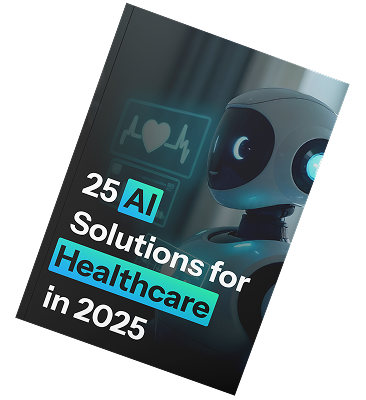The Cost of AI in Healthcare | Implementation, Integration, and Development in 2025

The market shows strong momentum in 2025. AI in healthcare reached $26.57 billion in 2024, and experts predict it will grow to $187.69 billion by 2030. This represents remarkable growth in healthcare technology investments over six years.
In addition, these investments help tackle significant challenges, like the World Health Organization’s predicted shortage of 11 million health workers by 2030.
The implementation costs of artificial intelligence in healthcare typically range from $100,000 to $500,000+, depending on the complexity of the solution.
However, the total cost goes beyond just implementation and development. Data preparation and cleaning, often overlooked yet vital, can take up to 60% of the original project budget.
But even if the upfront costs may seem high, AI implementation in healthcare pays off in the long run. PubMed Central research shows that AI in diagnosis saves about $1,600 daily per hospital in year one, growing to $17,800 by year ten.
Treatment costs drop by $21,600 daily per hospital in the first year, reaching $289,634 by year ten.
To help you achieve similar returns while navigating the complex investment landscape, our comprehensive guide examines:
- Implementation costs across AI technologies, including chatbots, computer vision, and predictive analytics
- Key factors influencing total AI development and deployment expenses
- Detailed cost breakdowns for developing specific healthcare AI solutions
- Proven strategies to identify and minimize hidden AI implementation costs
What is the Cost of Implementing AI in Healthcare?
AI integration in healthcare requires careful financial planning. The costs vary depending on how complex and customized the system needs to be.
Here is our analysis of the most common AI solution implementation and integration costs.
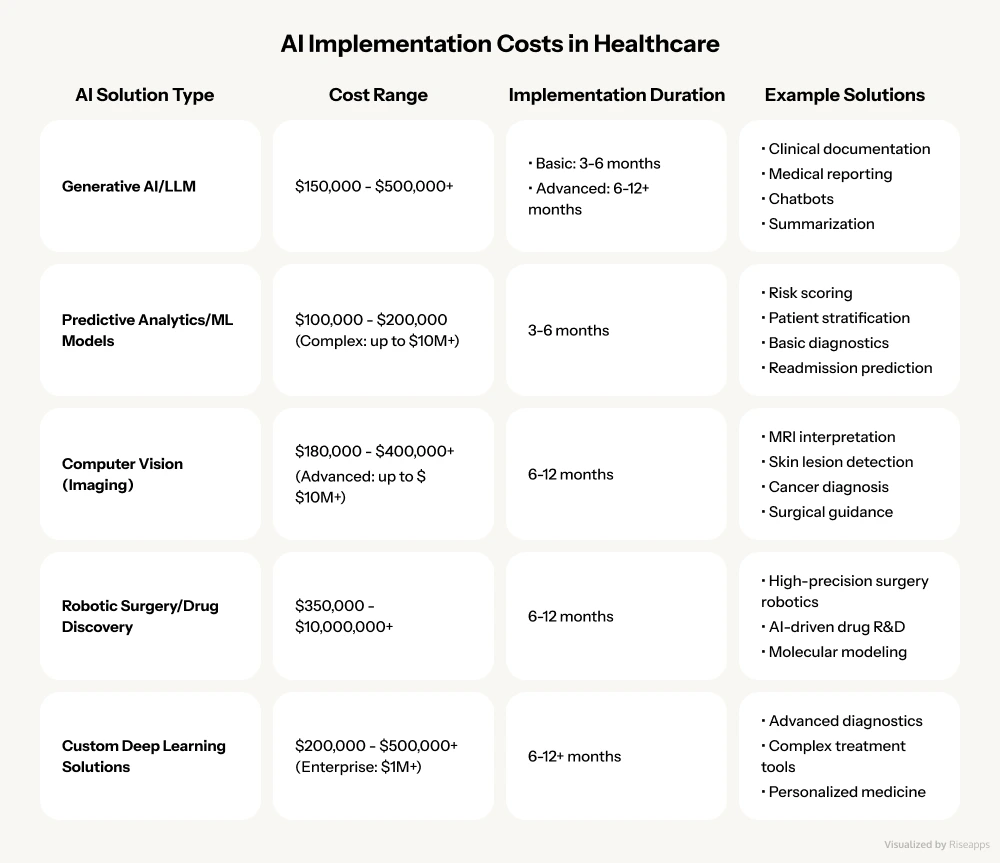
Generative AI/ LLM Implementation Cost
- Estimated cost: $150,000 to $500,000+
- Implementation duration:
- basic projects: 3-6 months;
- advanced projects: 6-12+ months
- Example solutions: Clinical documentation, medical reporting, chatbots, summarization
Integrating Generative AI, particularly Large Language Models (LLMs), into healthcare holds transformative potential but involves considerable costs due to industry-specific requirements.
The sensitivity of healthcare data heavily influences costs, stringent regulatory compliance (such as HIPAA), demands for high accuracy, and the complexity of integrations with existing clinical systems.
- Development of basic LLM applications like simple chatbots can cost $25,000 to $80,000, and tools for automated note-taking may cost between $40,000 and $150,000, primarily leveraging existing models with minimal customization.
- Patient triage chatbots, automated clinical documentation, or medical summarization are more expensive given their need for domain adaptation and precision, typically ranging from $250,000 to $500,000 or more.
- Advanced applications (e.g. real-time claims processing, diagnostic support, or AI-driven drug discovery) demand extensive fine-tuning, multi-system integration, and robust validation. For highly specialized, safety-critical solutions, costs often exceed $500,000 and potentially reach several million dollars.
Key factors impacting cost include the model selection and level of customization. Off-the-shelf APIs (like those from OpenAI) can offer rapid deployment and lower initial expenses, charging per usage, but may become costly at scale and pose data privacy risks.
In contrast, fine-tuning open-source LLMs (such as Llama or Mistral) offers greater control and privacy, but requires significant investment in computational resources, expert personnel, and ongoing maintenance.
Despite the hefty upfront outlay, generative AI delivers measurable ROI. Hospitals that automate clinical documentation and claims processing can cut administrative workloads by 30%, translating to millions in annual savings.
Predictive Analytics/ML Models Implementation Cost
- Estimated cost: $100,000 – $200,000
- Implementation duration: 3-6 months
- Example solutions: Risk scoring, patient stratification, basic diagnostics
Implementing basic predictive analytics and machine learning (ML) solutions in healthcare, such as simple patient readmission prediction tools, may cost $35,000–$45,000, while more advanced ML algorithms typically range from $150,000–$200,000.
Projects involving complex neural networks can cost between $200,000 and $500,000, and comprehensive solutions integrating multiple data sources or advanced diagnostics may reach $1 million or more, with some highly complex projects surpassing $10 million.
Key cost factors include:
- the choice between custom versus off-the-shelf solutions (custom models are 30–40% more expensive),
- data collection and preparation (including labeling and annotation),
- integration with legacy electronic health record (EHR) systems.
Computer Vision (Imaging) Implementation Cost
Implementing Computer Vision (CV) in healthcare, particularly for medical imaging, represents a significant investment but offers substantial benefits. The costs are highly variable and depend on numerous factors, from the complexity of the task to the chosen technology stack.
Cost ranges for computer vision in healthcare:
- Basic image analysis (e.g., simple abnormality detection): The development cost for straightforward tasks might start around $50,000 – $150,000.
- Complex medical imaging interpretation (e.g., interpreting MRIs, detecting skin lesions, and cancer diagnosis): These solutions, which often leverage neural networks and deep learning, can range from $180,000 to $400,000+.
- Highly advanced solutions (e.g., real-time surgical guidance, multi-modal image fusion): These can reach $500,000 to $1 million+, with some cutting-edge applications potentially exceeding $10 million.
Robotic Surgery/Drug Discovery Implementation Cost
- Estimated cost: $350,000 – $10,000,000+
- Implementation duration: 6-12 months
- Example solutions: High-precision surgery robotics, AI-driven drug R&D
Drug discovery tools start at $350,000. Based on research data, they suggest new molecules and potential medicines. Complex chemical modeling drives up the cost.
Setting up these systems takes 6-12 months due to extensive training and testing. Yearly updates and maintenance costs reach 20-30% of the setup cost.
Implementing robotic surgery and AI-driven drug discovery in healthcare is exceptionally expensive, reflecting the advanced technology and rigorous safety standards required.
For example, acquiring a surgical robot (e.g., Intuitive da Vinci systems, CMR Versius, Stryker Mako) costs $500,000 to $2.5 million, with additional start-up expenses for specialized instruments ($200,000–$300,000).
Ongoing per-procedure costs, primarily for disposables and maintenance, add $2,500–$4,000 per surgery. Training surgeons and OR staff incurs further costs (about $6,000 per surgeon for initial training), and annual maintenance contracts typically range from $100,000 to $175,000.
Despite steep upfront investments, AI and robotics in drug discovery promise transformative returns through:
- R&D cost reductions (20–40%),
- accelerated time-to-market,
- improved success rates in clinical trials,
- discovery of novel drugs,
- vastly increased research efficiency.
These technologies offer organizations willing to commit to the long term the chance to gain a competitive and clinical edge.
Custom Deep Learning Solutions Implementation Cost
- Estimated cost: $200,000 to $500,000+
- Implementation duration: 6-12+ months
- Example solutions: advanced diagnostics solutions, complex treatment tools etc.
Custom Deep Learning (DL) solutions in healthcare represent highly specialized AI applications with substantial implementation costs due to their complexity, data requirements, and critical safety standards.
Development costs typically range from $200,000 to $500,000+ for advanced diagnostics, treatment recommendations, or complex image interpretation, with enterprise-level systems exceeding $1 million. Basic proof-of-concept projects may start around $50,000–$150,000 but rarely yield clinically deployable solutions.
Despite these significant investments, custom DL solutions offer transformative potential for revolutionizing diagnostics, personalizing medicine, and streamlining operations, with development costs generally 30-40% higher than off-the-shelf alternatives but offering unmatched customization and performance.
How Much Does It Cost To Develop AI Healthcare Software?
Building AI healthcare software costs a lot more than just writing code. The price varies based on the project’s complexity and needs.
For example, basic to mid-level AI healthcare projects cost between $50,000 and $500,000. However, complex custom AI solutions (advanced diagnostics or robotic systems) can cost more than $10 million.
Healthcare organizations can choose from three main ways to develop their AI solutions:
- Off-the-shelf AI models: These ready-made solutions require less upfront money. You’ll pay $10,000-$50,000 for integration plus some licensing fees.
- Customized AI models: These adapted solutions need more investment. Prices start at $50,000 based on how much customization you want.
- Built-from-scratch AI models: These fully custom solutions start at $100,000. Cutting-edge products can easily cost more than $500,000.
The project timeline also plays a big role in the total cost. Simple AI healthcare apps take 3-6 months to build. Complex systems need 6-12+ months or more.
Moreover, custom AI models take 6-12 months and cost 30-40% more than pre-made solutions.
However, AI healthcare software is worth the investment of money and time. McKinsey & Company says AI could automate up to 45% of admin tasks.
Below, we’ll explain in greater detail what shapes the total cost of an AI implementation project.
What Are the Key Factors Affecting the Cost of AI in Healthcare?
AI implementation in healthcare involves many cost factors, each adding to the total investment needed for a successful implementation.
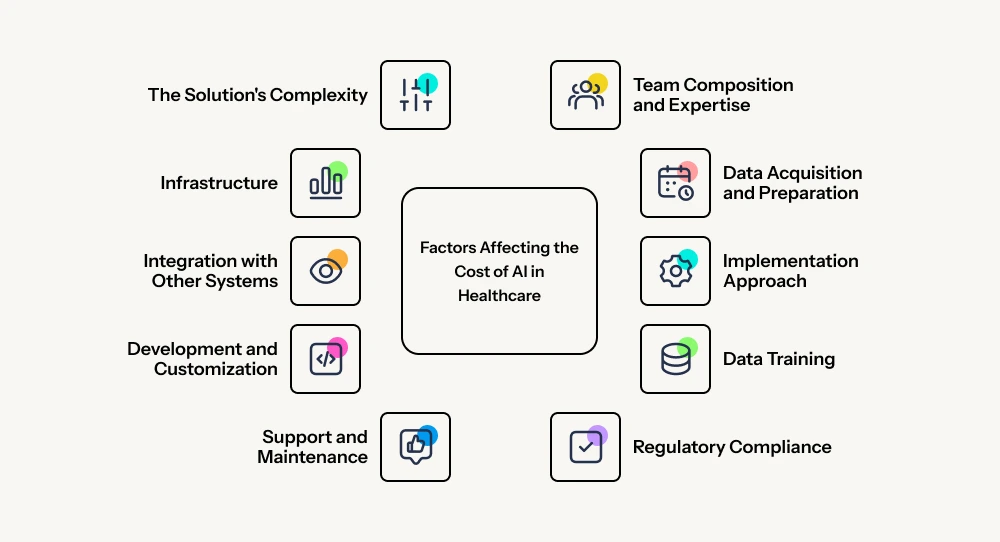
Here are the top ten key factors driving AI costs in healthcare, each with real-world insights.
Factor #1: The Solution’s Complexity and Performance Requirements
The complexity of an AI solution directly affects its cost. Simple tools, like AI for scheduling, are affordable, while advanced systems, such as IBM Watson for Oncology, which analyzes medical data for cancer treatment, are expensive.
Performance needs also shape the costs. AI projects with research elements can be tricky to budget. Developers can’t always predict when they’ll hit their accuracy and reliability targets. This uncertainty can push costs beyond planned budgets.
Here’s how costs increase from simple to complex solutions:
- Static machine learning models trained once (like readmission prediction classifiers) usually cost $35,000-$45,00,
- Complex deep learning models for cancer diagnosis reach $60,000-$100,00,
- Generative AI solutions cost even more because they need special expertise and heavy computing power to train at least two networks at once
Factor #2: Team Composition and Expertise
The team is one of the biggest costs in AI development. You’ll need:
- data scientists,
- ML engineers,
- developers,
- MLOps specialists,
- healthcare software developers,
- testers,
- business analysts,
- project managers.
Salaries take up much of the project budget. To name just some examples, according to job postings on Indeed:
- an AI director in the U.S. makes about $200,000,
- project managers earn over $120,000,
- data scientists get around $100,000,
- AI ethicists earn between $80,000 to $120,000.
Running a small AI center could cost $500,000 yearly just in salaries.
Hot job markets push costs higher. Machine learning engineers and data scientists can cost more than $300,000 yearly per person. Smaller organizations with limited budgets often outsource their projects to Europe-based agencies like Riseapps, which help cut costs while getting similar expertise.
Factor #3: Infrastructure
The infrastructure needed adds a big chunk to the total cost. You have three options:
- On-premises deployment: Buying and setting up hardware on your property gives you total control, but costs more upfront. Basic AI models need about $5,000 in infrastructure, standard deep learning models with decent GPUs cost $20,000-$50,000, while GAN models on powerful TPUs can jump to $100,000 or more.
- Cloud-based deployment: Cloud vendors host everything, which requires less upfront money but has monthly fees. A 2024 Deloitte report notes cloud solutions cut initial costs but raise long-term expenses. Simple AI models cost $430-$650 monthly, while complex ones can hit $5,000-$15,000 monthly.
- Edge AI deployment: This puts algorithms on local servers or medical devices to process data on-site. You’ll pay some upfront costs plus monthly fees.
- High-end infrastructure affects costs. AI needs top-tier cloud storage and computing power, which might cost $100,000 to $1 million yearly. Making old systems work with AI can add 20-30% to starting costs. That’s why choosing infrastructure that balances performance, compliance, and cost is critical.
Factor #4: Data Acquisition and Preparation
Quality data drives AI, but is costly to obtain and prepare. Labeled datasets, like MIMIC-III for critical care, may require purchase or institutional partnerships. Preparation (cleaning, normalizing, and labeling) is labor-intensive.
For example, annotating medical images for diagnostics needs expert input and hiking costs. Larger, diverse datasets amplify preparation efforts.
McKinsey estimates data tasks can take up to 60% of an AI budget. Efficient strategies, like synthetic data or automated labeling, can mitigate these expenses.
Factor #5: Integration with Other Systems
Integration adds more costs. Connecting AI with existing health records costs $7,800 to $10,400. APIs for medical devices cost at least $10,000. A custom user interface adds another $10,000 or more.
Integrating AI with systems like Epic or Cerner EHRs is complex and costly. It requires compatibility with diverse data formats and standards (e.g., HL7). HIPAA compliance adds further expense.
Costs rise with the number of systems involved. A well-planned integration strategy, focusing on key systems and standard protocols, helps manage costs.
Factor #6: Implementation Approach
Implementation choices impact costs. Here are common approaches:
- Building AI from scratch is flexible but expensive due to extensive development.
- Deploying pre-built platforms like Google’s Healthcare API reduces costs but limits customization.
- Customizing open-source tools (e.g., TensorFlow) offers a cost-effective middle ground.
Additionally, adapting an open-source model for a specific condition saves time. Cloud-based setups may reduce upfront costs compared to on-premise setups. That’s why selecting an approach aligned with project needs optimizes expenses.
Factor #7: Development and Customization
Development and customization drive costs. Creating custom AI solutions, like a patient outcome predictor, demands time and expertise. Customization adapts general models to specific needs, such as medical transcription.
Both require iterative testing for accuracy and compliance, increasing expenses. In addition, using pre-trained models (e.g., GPT) can cut costs by 30%, per a 2024 Gartner report. Efficient development and strategic customization keep costs in check.
Factor #8: Data Training
Training AI models is resource-heavy. Costs depend on:
- data volume,
- model complexity,
- computing power.
Training a radiology model, for instance, needs costly GPUs and weeks of runtime. Multiple iterations for accuracy add expenses. An MIT study pegs large model training at hundreds of thousands of dollars.
Validation for generalization further raises costs. Optimizing with transfer learning or efficient algorithms reduces this burden.
Factor #9: Support and Maintenance
Support and maintenance ensure AI longevity, adding to costs. AI maintenance runs 15-25% of initial development costs yearly.
Support includes training and troubleshooting; maintenance updates models with new data or regulations. For example, retrieving an AI quarterly with patient data maintains accuracy but costs more.
Compliance with evolving rules like HIPAA requires ongoing effort. Complex systems demand more support. Budgeting for continuous learning and updates is essential for sustainability.
Factor #10: Regulatory Compliance
Healthcare AI faces strict regulations and inflated costs. Meeting these regulations is another significant expense. Based on size and current compliance, HIPAA certifications range from $10,000 to over $150,000.
Under the SaMD framework, FDA approval for medical devices like diagnostic AI can cost millions and take years in the U.S.
The GDPR in Europe adds privacy requirements. Non-compliance risks fines and delays. A 2024 PwC report suggests compliance can be 20% of an AI budget. Early regulatory planning and legal collaboration are vital for cost management.
Cost of AI Healthcare Software Development Projects: 9 Real-Life Examples
AI integration in healthcare needs clear financial planning. Let’s look at some ground examples of AI healthcare software development costs across different specialties to help you learn about budgeting expectations and potential returns on investment.
Below you’ll find a detailed analysis of projects’:
- development costs,
- project durations,
- expected results,
- return on investment (ROI),
- and strategies to optimize costs.
This will help healthcare organizations understand what they’re getting into.
*Important Note: Consulting with AI development experts is recommended for more precise cost estimates.
Solution #1: AI Medical Summarization Software
- Approximate project cost: Small projects – $50,000-$100,000; medium projects – $100,000-$300,000; enterprise projects – $300,000-$500,000.
- Project duration: Small projects – 3-6 months; medium projects – 6-12 months; enterprise projects – 12-24 months.
- Results/ROI: By implementing AI medical summarization software, companies can achieve 40x faster medical summarization, 3x cheaper processing, and an average annual savings of $10,000 per professional, as seen in a PareIT case study.
▶️ See PareIT in action in the following demo.
AI medical summarization software uses natural language processing (NLP) to summarize medical records, reducing documentation time for healthcare and legal professionals.
Its technologies make documentation processes smoother and pull key insights from clinical data.
Healthcare technology companies can improve their medical summarization software by adding video recording capabilities. Companies that want specific features can opt for a simple version of a video/speech analysis AI platform.
These systems cost between $36,000 and $56,000, including speech-to-text functionality without user-facing components.
Development Cost Optimization Strategies:
- Utilize open-source NLP models like LLaMA or PaLM on HIPAA-compliant cloud servers (e.g., AWS).
- Start with a PoC to validate functionality, costing as low as $20,000 for 2 months, focusing on summarizing one document type.
- Outsource development to regions with lower labor costs (e.g., Eastern Europe, where rates are $25–$50/hour vs. $50–$100/hour in the US).
- Leverage cloud services to avoid upfront hardware costs.
Solution #2: AI Symptom Checking App
- Approximate project cost: Small projects – $30,000–$80,000; medium projects – $80,000–$200,000; enterprise projects – $200,000-$500,000+.
- Project duration: Small projects – 2-4 months; medium projects – 4-8 months; enterprise projects – 8-16 months.
- Results/ROI: With the development of AI symptom checking apps, healthcare organizations can reach $100 million in annual revenue, facilitate early intervention, potentially reducing treatment costs and decrease healthcare professional workload by triaging minor cases as stated in the success story by Black Doctor 24/7.
▶️ See Black Doctor 24/7 in action in the following demo.
An AI symptom checking app is a mobile or web-based solution that uses AI to assess patient symptoms and provide preliminary guidance, reducing the burden on healthcare providers.
These applications vary in cost based on their complexity and capabilities. Industry analysis shows three distinct tiers:
- Simple AI diagnosis apps with symptom checkers or triage tools cost between $30,000 and $60,000. These apps use rule-based AI or lightweight machine learning models.
- Mid-level applications with image recognition, EHR integration, and up-to-the-minute decision support range from $70,000 to $150,000. These solutions need resilient AI components, secure backends, and medical data licensing.
- Advanced AI medical diagnosis apps using deep learning, NLP, or predictive diagnostics cost between $200,000 and $500,000+. These solutions often go through FDA review and clinical validation for hospital use.
Companies starting their development journey can build a Minimum Viable Product (MVP) for $20,000 to $50,000. These MVPs include core features like symptom checkers and simple diagnostics using basic AI.
Development Cost Optimization Strategies:
- Use pre-built AI chatbot frameworks like Dialogflow or Rasa.
- Integrate with existing telehealth platforms to minimize custom development.
- Focus on core symptom-checking features for the initial release, iterating based on user feedback.
- Leverage cloud-based NLP services to reduce infrastructure costs.
Solution #3: AI Triage Chatbots and Assistants
- Approximate project cost: Small projects – $40,000-$100,000; medium projects – $100,000-$250,000; enterprise projects – $250,000–$500,000.
- Project duration: Small projects – 3-6 months; medium projects – 6-12 months; enterprise projects – 12-18 months
- Results/ROI: By building custom AI triage chatbots and assistants, medical companies can reduce care delivery overheads by 40%, achieve 100% HIPAA compliance, and screen 30,000+ patients across 800+ locations, enhancing access to care as demonstrated in a Black Doctor case study. With a revenue goal of $100M, cost savings, and increased patient throughput, organizations can yield significant returns within 2–3 years.
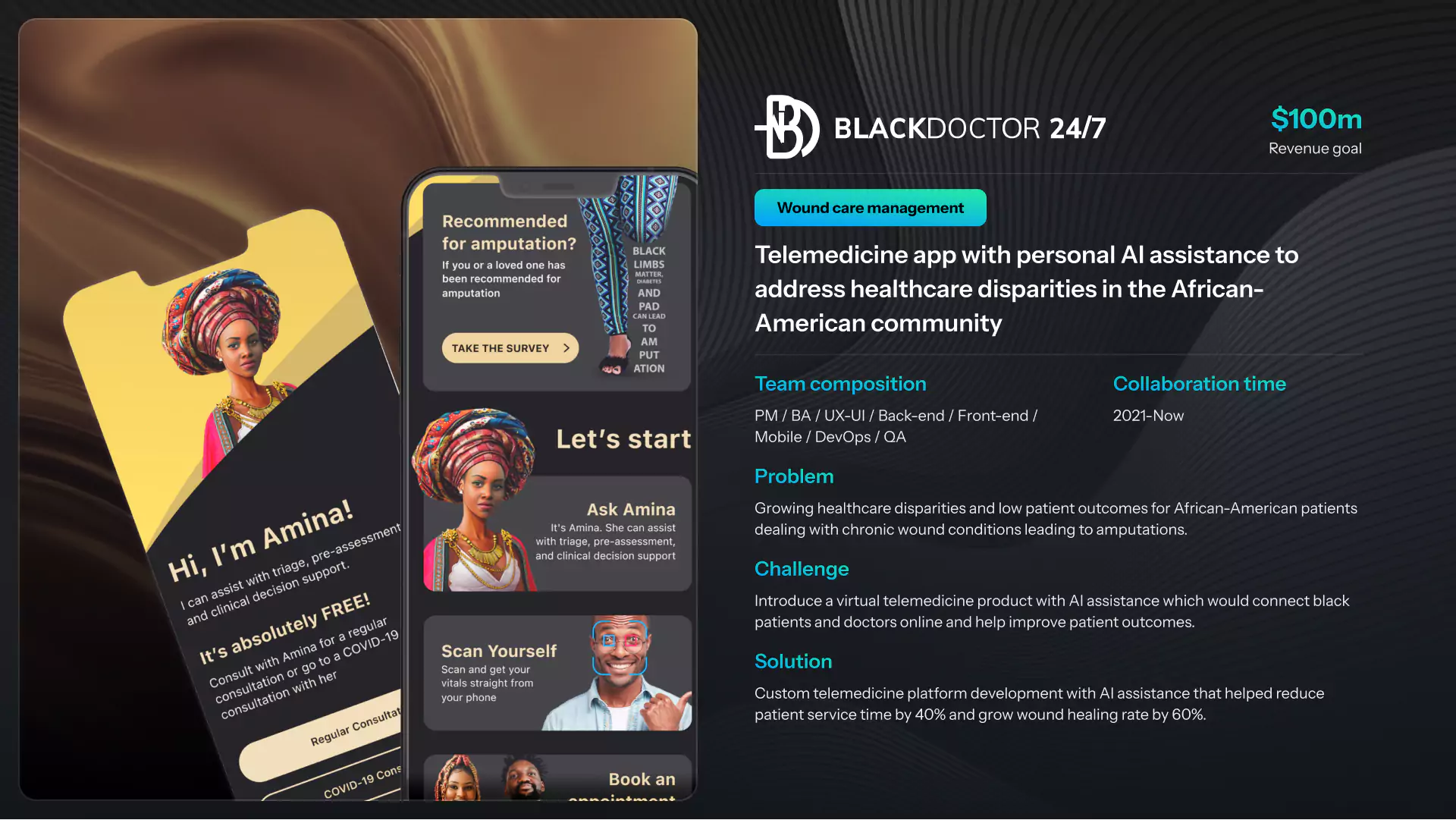
Healthcare chatbot costs depend on complexity. Simple AI chatbots cost between $50,000 and $100,000. Advanced versions like Google’s AMIE range from $40,000 to $400,000.
These premium solutions include advanced natural language processing, personalized recommendations, and predictive analytics.
More complex AI patient triage systems (like Boston Medical Center’s one) can cost up to $2.1 million but save $1.4 million annually by cutting unnecessary emergency room visits and improving staff schedules.
Development Cost Optimization Strategies:
- Leverage existing NLP platforms like Google Cloud Natural Language.
- Use certified cloud services for HIPAA compliance to reduce compliance costs.
- Partner with healthcare providers for real-world data and validation.
- Start with a minimum viable product (MVP) to test triage algorithms.
Solution #4: AI Treatment Plan Generation Software
- Approximate project cost: Small projects – $60,000 – $150,000; medium projects – $150,000 – $400,000; enterprise projects – $400,000 – $800,000
- Project duration: small projects – 4- 8 months; medium projects – 8-16 months; enterprise projects – 16- 24 months.
- Results/ROI: With custom AI treatment plan generation software, medical organizations can see a 65% increase in caregiver efficiency and a 50% reduction in documentation time, cut operational costs by 40–60% compared to subscription-based software, and improve care plan accuracy by 20–30%, as per a dementia management case study.
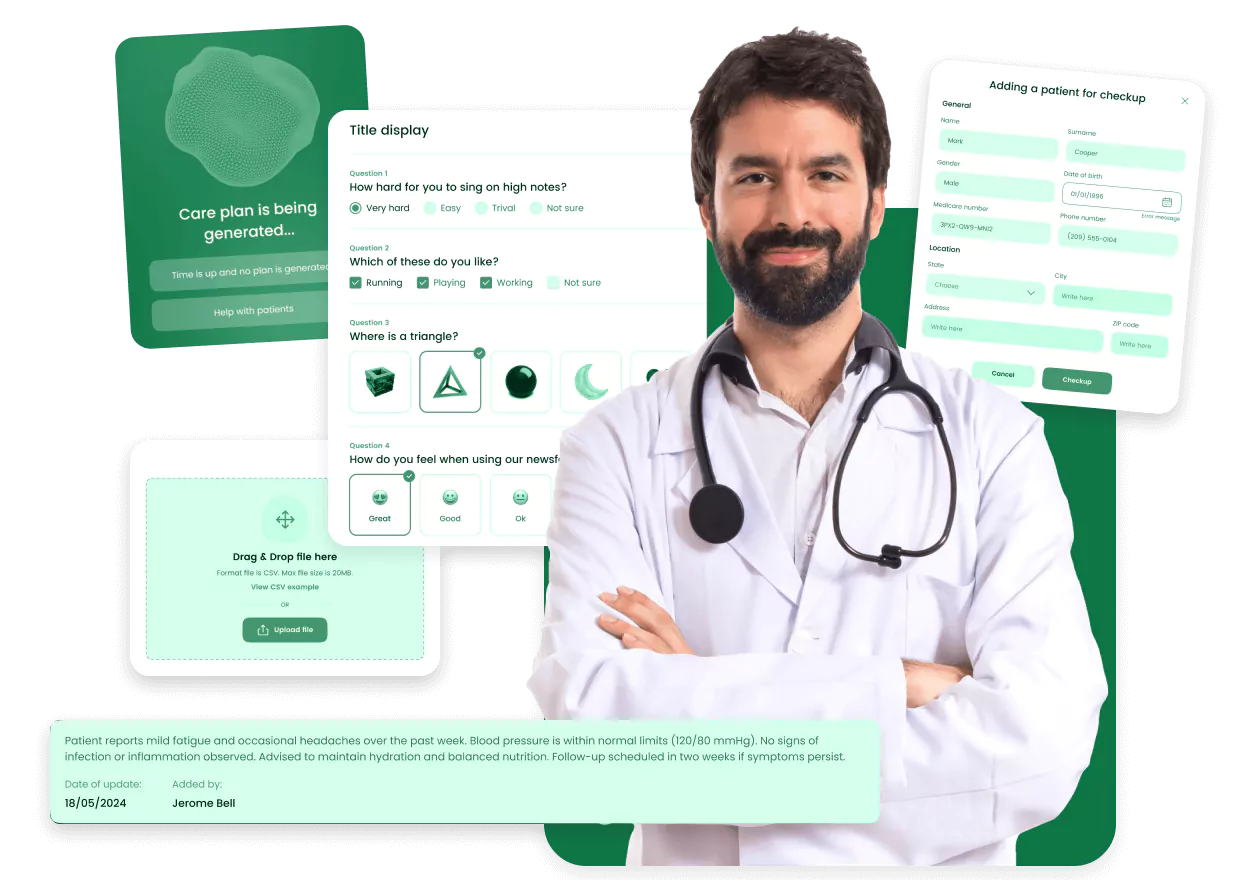
AI treatment plan generation software is one of the most promising tools in healthcare technology. Before AI, signing one treatment plan cost about $600 and took 4 hours of physician time.
AI reduced this to $200 per care plan and only 30 minutes of physician time.
Multiple large language models work together to power these improvements. One system uses Claude and Titan on AWS Bedrock with RAG to generate accurate plans. The processing is efficient—just 4 minutes of AWS Bedrock usage costs $10 for a care plan draft ready for physician signature.
The yearly financial benefits are clear. AI treatment plan generation software saves about $95,000 per physician annually. Doctors can now complete 30 care plans weekly instead of 10. This improvement comes from cutting plan creation time from 4 hours to 30 minutes.
Banner Health’s AI documentation assistant helps doctors with paperwork. The tool automatically fills parts of medical records based on patient conversations and suggests billing codes. The $1.7 million investment led to $5.3 million yearly savings through better medical coding and less physician burnout.
Development Cost Optimization Strategies:
- Use pre-trained machine learning models for treatment algorithms.
- Integrate with existing EHR systems to reduce development scope.
- Prioritize high-impact conditions for initial deployment.
- Leverage cloud computing for scalable data processing.
Another cost optimization option is integrating AI care plan generator.
▶️ Explore Riseapps’ AI treatment plan generator to see how it revolutionizes personalized healthcare delivery or watch a demo below.
Solution #5 AI Medical Imaging and Diagnostics Software
- Approximate project cost: small projects – $100,000- $300,000; medium projects – $300,000- $700,000; enterprise projects – $700,000- $1,500,000.
- Project duration: small projects 6- 12 months; medium projects – 12- 24 months; enterprise projects – 24- 36 months.
- Results/ROI: custom AI medical imaging and diagnostics software can save 3.3 hours per day on diagnosis, reduce false positives by up to 30% in mammography screening, improve diagnostic speed and yield returns within 2–4 years, depending on adoption scale.
Medical FDA-approved solutions help radiologists and specialists spot problems in X-rays, MRIs, CT scans, and other images, improving accuracy and speed.
Based on its capabilities, AI medical imaging software development costs between $300,000 and $2 million. A simple chest X-ray tool might cost $300,000-$500,000, while a complete platform that handles multiple types of images could cost more than $1.5 million.
The main things that affect the cost of solutions are:
- Imaging modalities covered: Each new type of imaging adds to the cost because it needs special training.
- Annotation requirements: Expert-labeled images for training can cost $100,000 or more for rare conditions.
- Accuracy requirements: Better accuracy needs bigger datasets and more intelligent algorithms, which cost more.
- Hardware requirements: Processing medical images requires powerful computers, which add $50,000-$200,000 for on-site setups.
FDA clearance for diagnostic applications is a big deal, as you’ll need 6-18 extra months and $100,000-$500,000 more for regulatory work.
Imaging AI shows clearer returns than other healthcare AI tools through:
- 15-30% faster image interpretation
- More accurate diagnoses, especially for early detection
- Better workflow for radiologists and less burnout
- More patients handled without extra staff
Solution #6: AI-Powered Scheduling & Administration Software
- Approximate project cost: small projects – $40,000-$100,000; medium projects – $100,000-$250,000; enterprise projects – $250,000-$500,000.
- Project duration: small projects – 3-6 months; medium projects – 6-12 months; enterprise projects – 12-18 months.
- Results/ROI: Building AI-powered scheduling software optimizes appointment scheduling, reducing wait times. Automating routine tasks decreases administrative overhead, improving patient flow and enhancing satisfaction.
Healthcare wastes a lot of money on administrative tasks. AI-powered scheduling and administration tools help fix this by:
- optimizing appointments,
- predicting no-shows,
- managing staff,
- making workflows better.
These AI solutions cost between $100,000 and $700,000, making them cheaper than clinical tools. A simple scheduling system costs $150,000-$250,000, while an enterprise system with advanced features might run $500,000-$700,000.
The costs break down like this:
- Core algorithm development: $75,000-$200,000
- User interface development: $50,000-$150,000
- Integration with existing systems: $25,000-$200,000
- Data migration and preparation: $15,000-$100,000
- Testing and deployment: $25,000-$100,000
Administrative AI tools pay off faster than clinical ones. Many organizations see positive returns within 12-18 months through:
- 20-30% fewer no-shows
- 10-15% better provider schedule use
- Lower administrative staff needs
- Happier patients due to better scheduling
These systems also face less regulatory scrutiny than clinical tools, which makes them easier to develop and deploy.
Development Cost Optimization Strategies:
- Adapt existing scheduling algorithms with AI enhancements.
- Integrate with current administrative systems to minimize custom coding.
- Use cloud-based solutions for scalability and cost efficiency.
- Start with core scheduling features and expand based on feedback.
Solution #7: AI-Driven Clinical Documentation & Virtual Scribes App
- Approximate project cost: small projects – $50,000-$120,000; medium projects – $120,000-$300,000; enterprise projects – $300,000-$600,000.
- Project duration: small projects – 3-6 months; medium projects – 6-12 months; enterprise projects – 12-24 months.
- Results/ROI: It reduces documentation time, allows more patient interaction, improves record accuracy with NLP-driven transcription, reduces clinician burnout, and improves efficiency.
This AI healthcare software automates clinical documentation, acting as a virtual scribe to reduce clinician workload. They may have basic speech-to-text scribe functionality, offer NLP and EHR integration, or provide real-time transcription capabilities.
Development Cost Optimization Strategies:
- Leverage speech recognition technologies like Google Speech-to-Text.
- Use cloud-based NLP services for cost-effective processing.
- Ensure interoperability with existing EHR systems.
- Start with a pilot in a single department to validate functionality.
Solution #8: AI-Powered Remote Patient Monitoring & Virtual Care Software
- Approximate project cost: small projects – $60,000–$150,000; medium projects – $150,000–$400,000; enterprise projects – $400,000–$800,000.
- Project duration: small projects – 4–8 months; medium projects – 8–16 months; enterprise projects – 16–24 months.
- Results/ROI: Continuous monitoring improves outcomes and reduces readmissions. Virtual care reduces hospital visit costs.
This type of AI medical software monitors patients remotely using AI, enabling virtual care and reducing hospital visits.
Development Cost Optimization Strategies:
- Use existing IoT devices and monitoring technologies.
- Integrate with telehealth platforms to reduce development scope.
- Focus on high-risk patient groups for initial deployment.
- Leverage cloud services for data storage and processing.
Solution #9: AI Drug Discovery Software
- Approximate project cost: small projects – $200,000–$500,000; medium projects – $500,000–$1,000,000; enterprise projects – $1,000,000–$2,000,000+
- Project duration: small projects – 6–12 months; medium projects – 12–24 months; enterprise projects – 24–36 months.
- Results/ROI: AI drug discovery software development accelerates drug discovery, lowers preclinical trial costs by identifying viable candidates early, and increases success rates in clinical trials, per a PMC study.
Development Cost Optimization Strategies:
- Collaborate with pharmaceutical companies for data and funding.
- Use open-source bioinformatics tools like RDKit.
- Leverage cloud computing for high-performance data analysis.
- Start with a focused drug target to validate the platform.
Hidden Costs of Implementing Artificial Intelligence in Healthcare (And How to Mitigate Them)
Projects often go over budget due to hidden costs. Deloitte Healthcare found 63% of healthcare AI projects went over budget by 25% or more.
Extra costs pop up during implementation that can quickly blow up budgets and hurt ROI if you don’t plan for them.
This happens because of data cleaning issues, integration problems, and longer training times. A good grasp of these underlying costs helps plan better and deploy successfully.
Talent Acquisition & Training: The “Brain Drain” Tax
People are one of the biggest yet often overlooked expenses when implementing healthcare AI. Finding qualified AI specialists in today’s competitive market can cost each professional over $300,000 a year.
Even medium-sized healthcare organizations might have to set up an AI excellence center with specialized staff.
The salaries could reach $500,000 for a small team.
Good training programs are essential for clinical and administrative staff to use AI tools effectively.
Research in the Journal of the American Medical Informatics Association shows that successful AI requires 15-20% of the total project budget for training and change management. Each person’s training costs $5,000-$10,000, depending on the complexity.
Small organizations face special challenges. Many can’t match the high salaries needed to attract top AI talent. Outsourcing often works better, giving access to expertise without the full cost of permanent staff.
Mitigation Strategy: Embrace a “Grow and Glue” Strategy
- Start with a staged hiring plan that matches implementation phases instead of hiring everyone at once.
- Try part-time Chief AI Officers to cut costs while keeping strategic direction.
- Instead of bankrupting yourself chasing unicorn data scientists (though you might need one or two), invest heavily in upskilling your current superstars.
- Complement this with strategic hires focused on integration – people who can “glue” the AI into existing workflows and translate between tech and clinical teams.
- Train your current IT staff in AI to build internal talent and rely less on expensive external hiring.
- Partner with universities for pipelines.
AI development in healthcare comes with more than just the upfront price tag. Extra costs pop up during implementation that can quickly blow up budgets and hurt ROI if you don’t plan for them.
A good grasp of these underlying costs helps plan better and deploy successfully.
Project Management & Oversight: The Invisible Engine Room
Implementing AI isn’t plug-and-play. It demands meticulous project management:
- defining scope,
- managing vendors,
- integrating with ancient EHRs,
- testing rigorously,
- ensuring compliance,
- navigating unexpected hiccups.
Underestimating this is like planning a moon landing without mission control.
Mitigation Strategy: Dedicate the Right Captain (and Crew).
- Don’t tack this onto someone’s already overflowing plate.
- Appoint a dedicated, experienced project manager with healthcare IT/AI implementation knowledge.
- Establish a cross-functional steering committee (IT, clinical, admin, legal) from day one.
This upfront investment prevents costly delays, scope creep, and failed deployments later.
Vendor Lock-in & License Renewals: The Subscription Trap
Many AI solutions are cloud-based SaaS models. Initial costs might seem manageable, but vendor lock-in is real. Annual license renewals often come with hefty, unpredictable increases.
In addition, they can become expensive due to data migration complexities and workflow dependencies.
Mitigation Strategy: Demand an Exit Strategy Before Entry
- Negotiate before signing and use license optimization techniques.
- Insist on clear data ownership clauses and accessible APIs for easy data extraction.
- Understand the total cost of ownership over 3-5 years, including projected renewal fees.
- Explore modular solutions or open-source options where feasible.
- Build internal capability to reduce reliance on a single vendor’s black box.
Change Management: The Human Resistance Factor
Doctors, nurses, and staff are busy saving lives, not itching to learn a new complex system. However, poorly managed adoption leads to frustration, workarounds, errors, and ultimately, shelfware.
As a result, your AI initiative can lead to potential chaos.
Mitigation Strategy: Treat it Like a Clinical Trial, Not a Software Drop
- Involve end-users early and often in design and testing.
- Provide ongoing, role-specific training (not just a one-off session).
- Communicate relentlessly about the why and the benefit to them and the patients.
- Identify champions and celebrate small wins.
- Address fears about job displacement head-on.
Maintenance & Evolution: The Never-Ending Tune-Up
AI models degrade. Data drifts. Clinical guidelines change. Regulatory landscapes shift. That brilliant algorithm you bought today needs constant feeding (new data), retraining, monitoring, and updating to stay accurate and relevant. It’s a living thing, not a static appliance.
Mitigation Strategy: Budget for the AI Lifecycle, Not Just Birth.
- Factor in ongoing costs for data pipeline maintenance, model monitoring tools, retraining cycles, and dedicated personnel (or vendor SLAs) for upkeep from the initial business case.
- Treat AI maintenance like essential medical equipment servicing – non-negotiable for safety and efficacy.
Ethics, Bias & Governance: The Cost of Getting it Wrong
AI trained on biased data produces biased results, potentially exacerbating health disparities. Lack of clear governance around data use, model explainability, and accountability opens the door to:
- ethical breaches,
- patient harm,
- legal liability,
- devastating reputational damage.
Here are some approaches to mitigating the risks.
Mitigation Strategy: Bake Ethics In, Don’t Sprinkle On
- Establish a multidisciplinary AI ethics review board before deployment.
- Prioritize tools with explainable AI (XAI) capabilities.
- Rigorously audit training data for bias and continuously monitor model outputs across diverse patient populations.
- Develop clear governance frameworks covering data use, consent, and accountability.
Compute, Energy & Sustainability: The Invisible Power Drain
Training complex AI models, especially on massive healthcare datasets, requires immense computational power, translating directly to soaring cloud computing bills and significant energy consumption.
This has a real financial and environmental cost that’s often overlooked.
Mitigation Strategy: Optimize Like Your Budget (and Planet) Depends on It
- Work with vendors like Riseapps to explore computationally efficient model architectures.
- Consider federated learning approaches that train models locally on devices or hospitals without centralizing sensitive data, reducing data transfer and compute needs.
- Evaluate cloud providers’ energy efficiency. Monitor usage closely—turn off non-essential resources. Think green AI; it’s cost-effective and responsible.
Implementing AI in healthcare isn’t just about the price of the software license.
It’s a complex organizational transformation with layers of hidden investment. Implementing these innovative mitigation strategies, you transform potential budget sinkholes into calculated, valuable assets.
Foresight is your most powerful diagnostic tool here. Use it wisely, and your AI journey will be healthy for both patients and your bottom line.
Transform Your Healthcare Vision with Riseapps
Ready to revolutionize healthcare with AI? At Riseapps, we specialize in building scalable, HIPAA-compliant AI solutions tailored to your healthcare needs.
From AI medical summarization that delivers summaries 5x faster and 4x cheaper to AI triage chatbots driving $100M in revenue, our proven expertise empowers healthcare teams to launch innovative platforms quickly.
Whether it’s custom EHR integrations, patient portals, or advanced AI modules for triage and care plans, we ensure seamless integration with systems like Epic and Cerner while meeting GDPR and ISO standards.
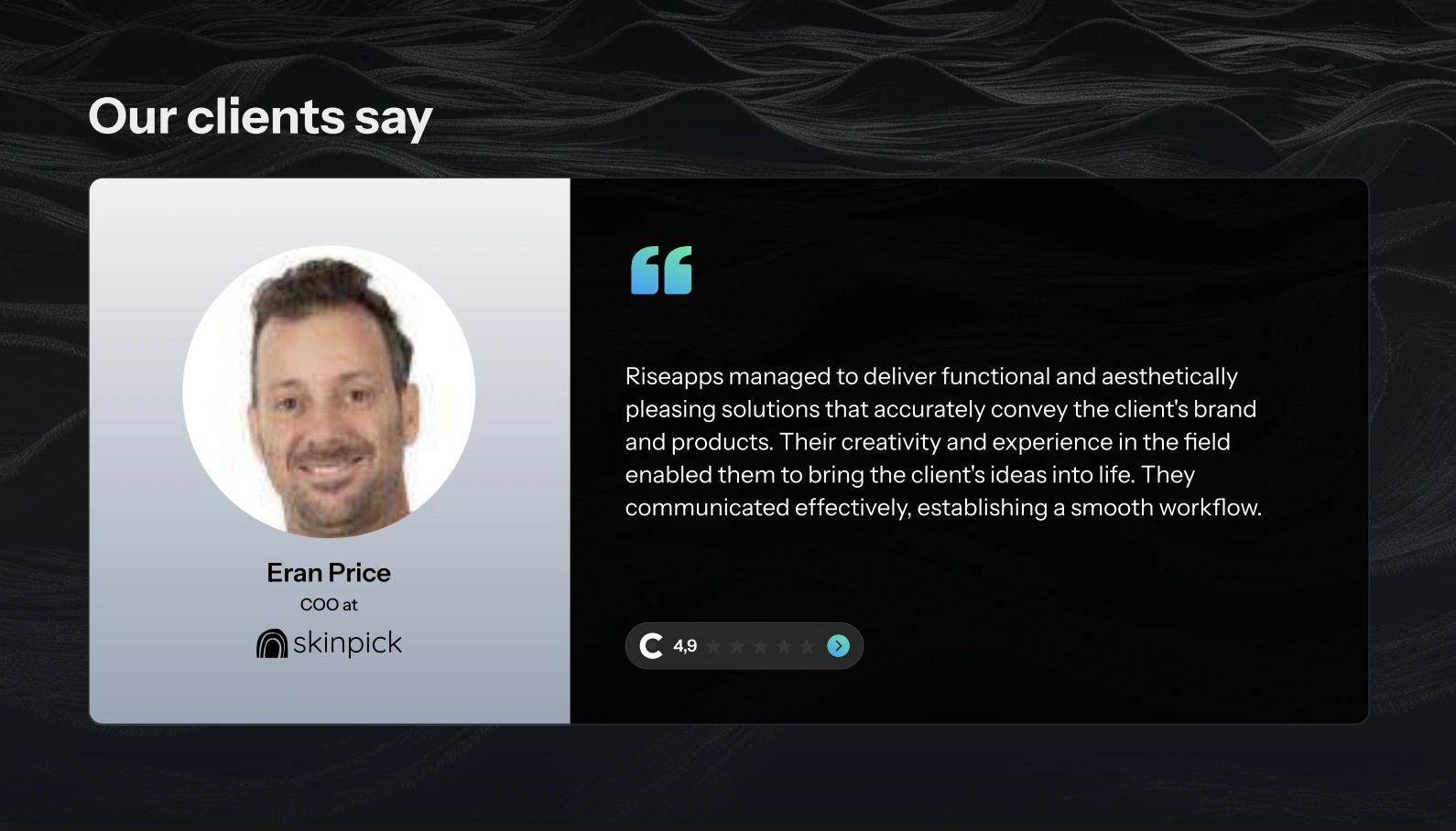
Why Choose Riseapps?
- Proven Impact: Our AI solutions have achieved 85% accuracy in care plan recommendations and saved providers over 100,000 hours annually.
- Rapid Delivery: Kickstart your project in just 7 days with our streamlined process, from discovery to MVP in 3–5 weeks.
- Comprehensive Services: We offer full product builds, AI module development, compliance audits, and team extensions to fit your goals.
Ready to get started? Explore how Riseapps can bring your AI healthcare vision to life.
FAQ
How much does it cost to use AI in healthcare?
AI healthcare implementation costs range from $20,000 for small projects to over $1,500,000 for enterprise solutions, depending on complexity, compliance, and scope. Factors like data needs and integration impact costs, with ROI from efficiency gains.
How will AI affect healthcare financially?
AI in healthcare can reduce costs by automating tasks, improving efficiency, and minimizing errors, potentially saving billions annually. However, high initial development costs ($20,000-$1.5M+) require strategic planning to achieve strong ROI through enhanced outcomes and streamlined operations.
How much does AI treatment cost?
The cost of developing AI treatment solutions, like personalized care plan generation, ranges from $20,000-$150,000 for small projects to $400,000-$800,000 for enterprise systems. Costs vary based on complexity, data integration, and compliance requirements. ROI comes from improved outcomes and efficiency.
What are the cost implications of integrating AI in healthcare systems?
Integrating AI in healthcare demands significant investment (from $20,000 chatbot pilots to multimillion-dollar diagnostic platforms) covering development, data management, infrastructure, compliance, and specialized talent. Ongoing maintenance and regulatory audits add 30–50% annually, offset by efficiency gains.
Contact Us



